Men and Women Equal Payment in Global CSR: An In-Depth Analysis
VerifiedAdded on 2023/06/08
|8
|1675
|367
Report
AI Summary
This report examines the critical issue of equal pay for men and women within the context of global Corporate Social Responsibility (CSR). It begins by outlining the importance of gender equality and its integration into workforce diversity initiatives. The report then delves into a literature review of CSR, referencing Carroll's CSR pyramid model and various perspectives on CSR implementation. Key challenges, such as considering the impact of the internal and external business environment and addressing diverse stakeholder interests, are discussed. The stakeholder theory is highlighted to emphasize the importance of balancing the needs of shareholders, employees, and customers. The report cites statistics on gender pay gaps and the underrepresentation of women in leadership roles. Finally, the report presents case studies of Telstra and Commonwealth Bank, detailing their efforts to promote gender equality and address pay equity gaps. The report concludes by reiterating the importance of fair treatment of human capital and the ongoing need for organizations to address gender pay disparities despite existing CSR efforts.
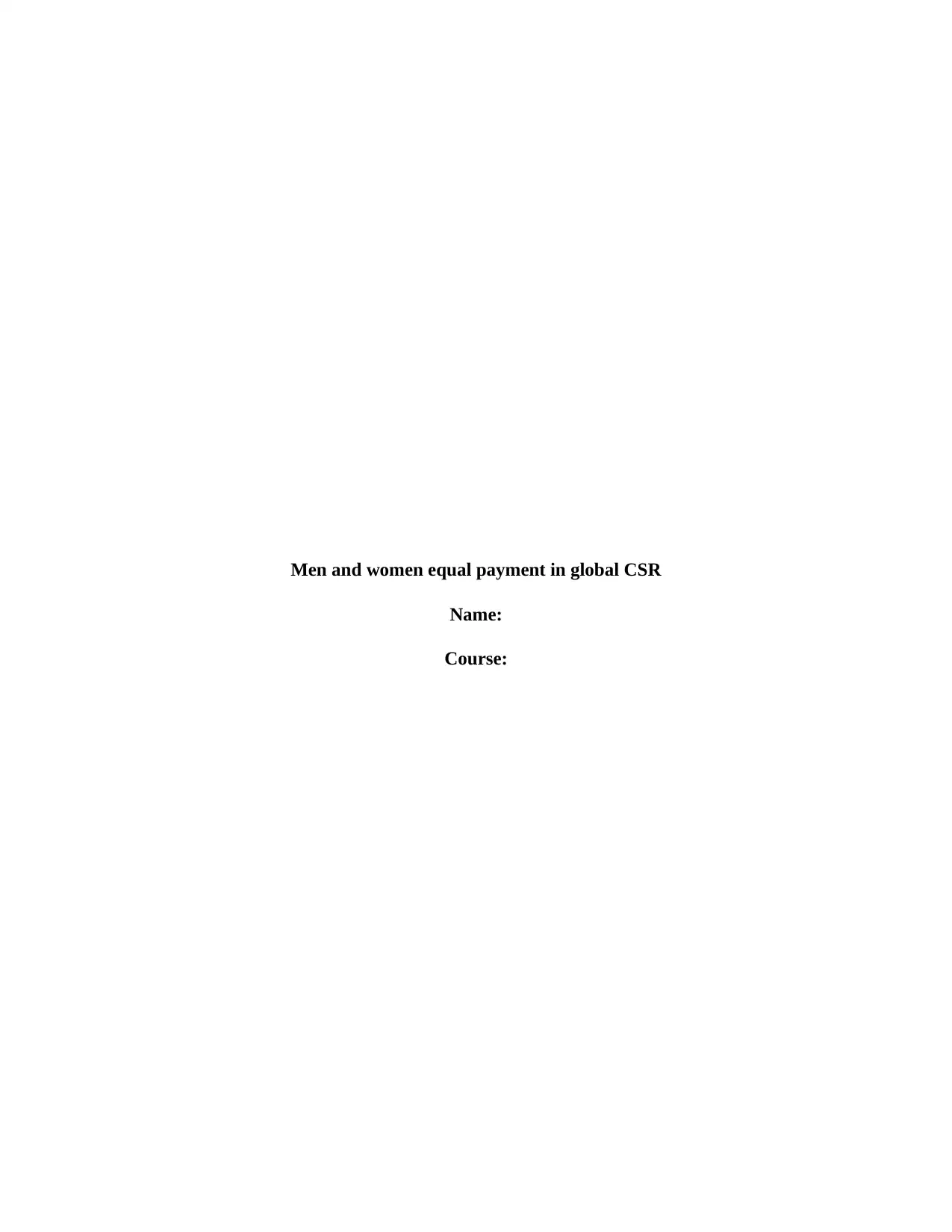
Men and women equal payment in global CSR
Name:
Course:
Name:
Course:
Paraphrase This Document
Need a fresh take? Get an instant paraphrase of this document with our AI Paraphraser
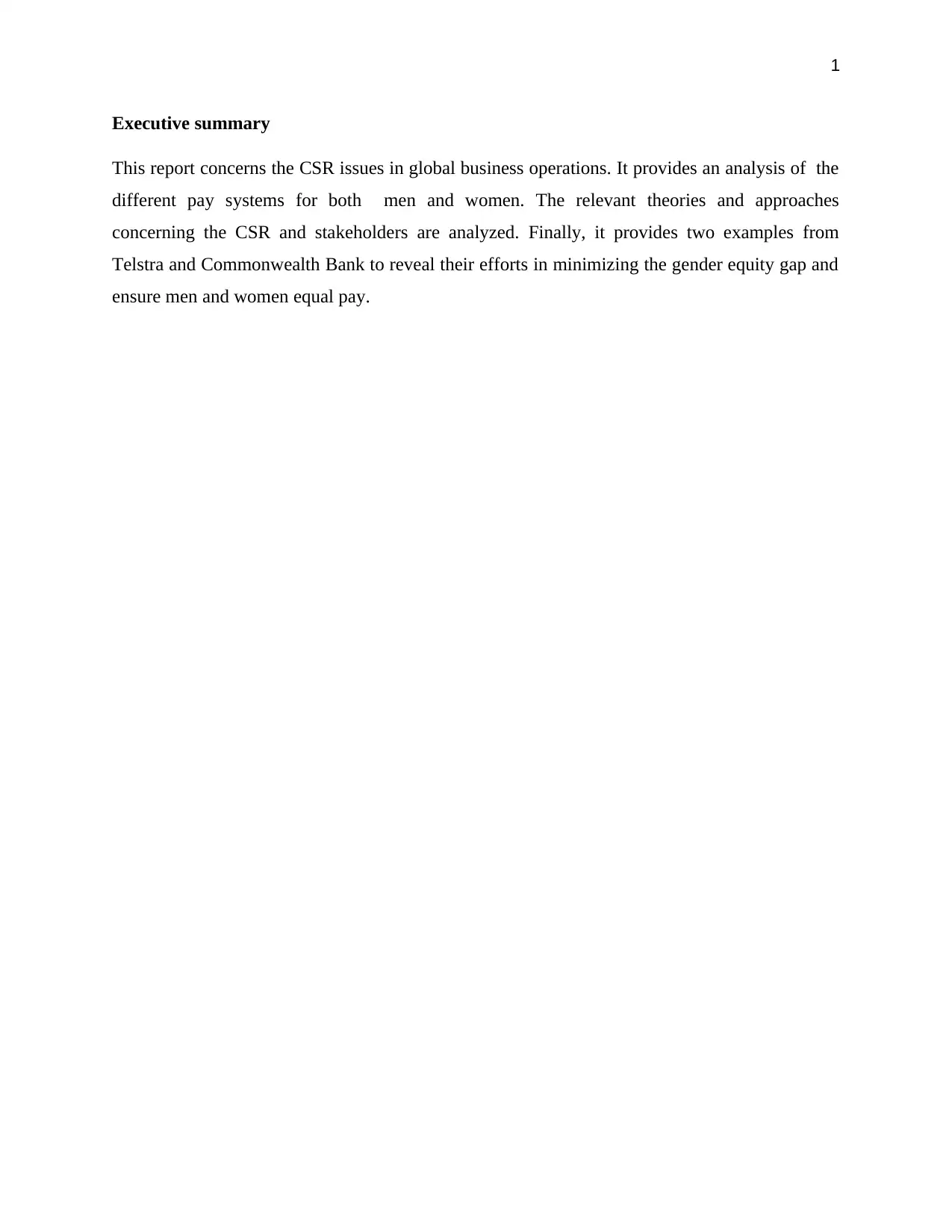
1
Executive summary
This report concerns the CSR issues in global business operations. It provides an analysis of the
different pay systems for both men and women. The relevant theories and approaches
concerning the CSR and stakeholders are analyzed. Finally, it provides two examples from
Telstra and Commonwealth Bank to reveal their efforts in minimizing the gender equity gap and
ensure men and women equal pay.
Executive summary
This report concerns the CSR issues in global business operations. It provides an analysis of the
different pay systems for both men and women. The relevant theories and approaches
concerning the CSR and stakeholders are analyzed. Finally, it provides two examples from
Telstra and Commonwealth Bank to reveal their efforts in minimizing the gender equity gap and
ensure men and women equal pay.
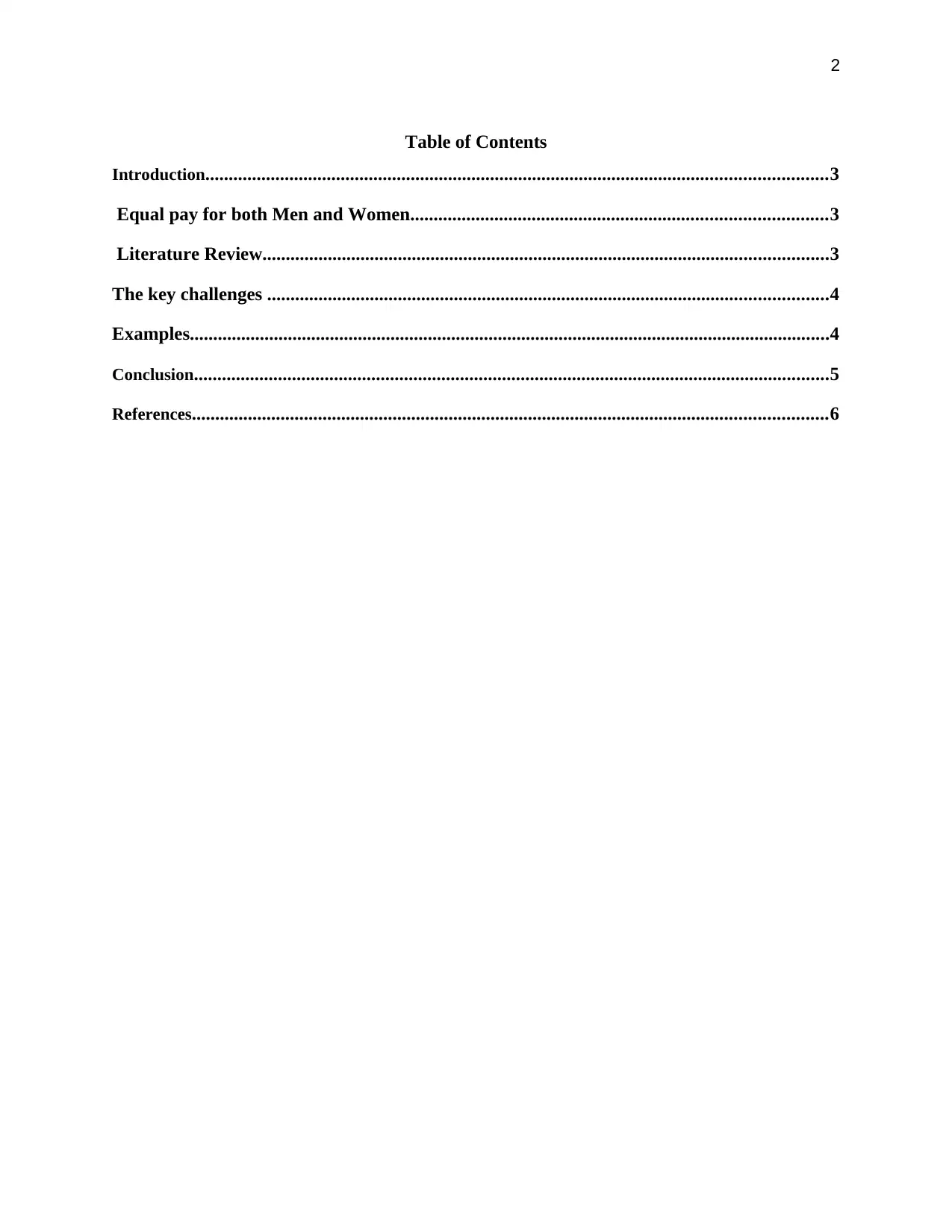
2
Table of Contents
Introduction.....................................................................................................................................3
Equal pay for both Men and Women.........................................................................................3
Literature Review.........................................................................................................................3
The key challenges ........................................................................................................................4
Examples.........................................................................................................................................4
Conclusion........................................................................................................................................5
References........................................................................................................................................6
Table of Contents
Introduction.....................................................................................................................................3
Equal pay for both Men and Women.........................................................................................3
Literature Review.........................................................................................................................3
The key challenges ........................................................................................................................4
Examples.........................................................................................................................................4
Conclusion........................................................................................................................................5
References........................................................................................................................................6
⊘ This is a preview!⊘
Do you want full access?
Subscribe today to unlock all pages.

Trusted by 1+ million students worldwide
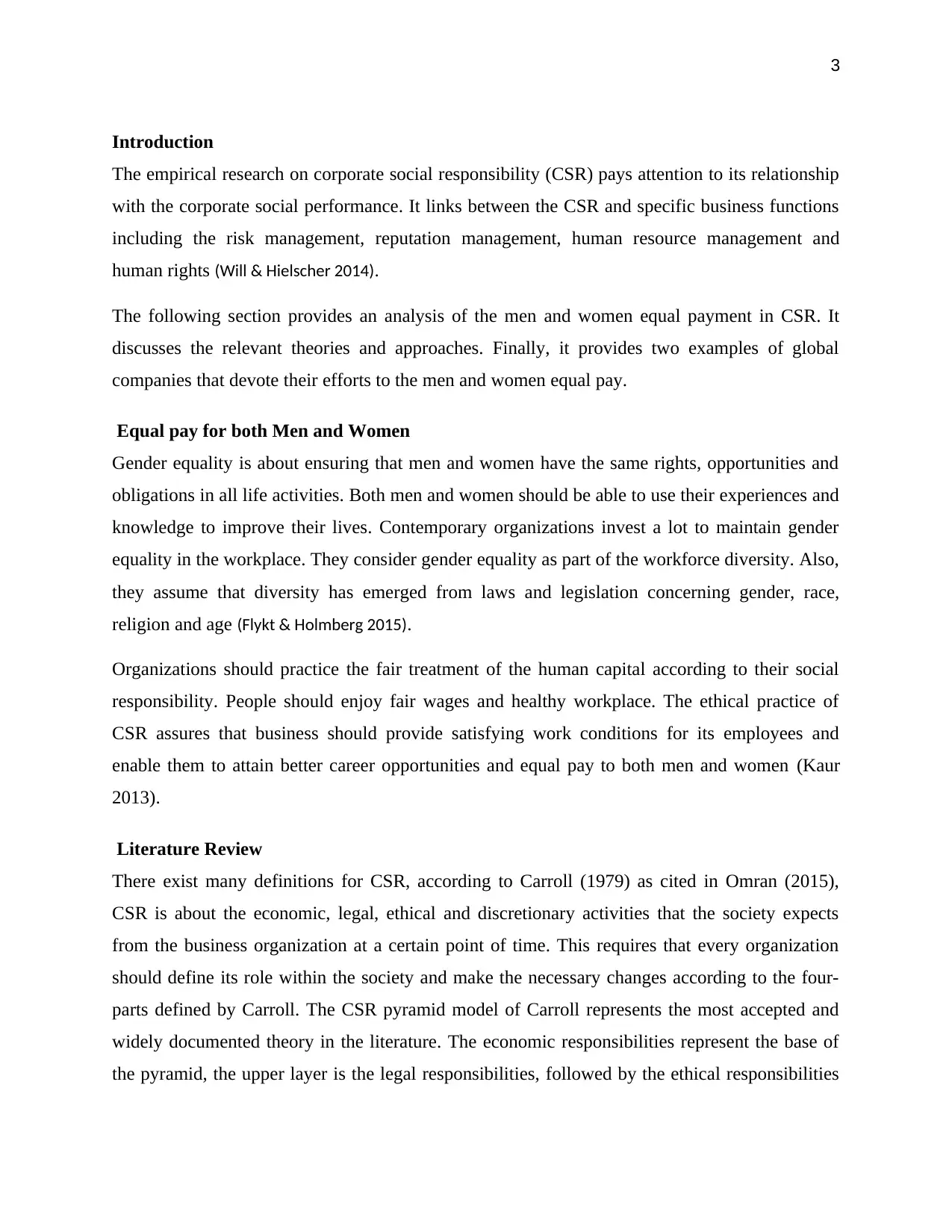
3
Introduction
The empirical research on corporate social responsibility (CSR) pays attention to its relationship
with the corporate social performance. It links between the CSR and specific business functions
including the risk management, reputation management, human resource management and
human rights (Will & Hielscher 2014).
The following section provides an analysis of the men and women equal payment in CSR. It
discusses the relevant theories and approaches. Finally, it provides two examples of global
companies that devote their efforts to the men and women equal pay.
Equal pay for both Men and Women
Gender equality is about ensuring that men and women have the same rights, opportunities and
obligations in all life activities. Both men and women should be able to use their experiences and
knowledge to improve their lives. Contemporary organizations invest a lot to maintain gender
equality in the workplace. They consider gender equality as part of the workforce diversity. Also,
they assume that diversity has emerged from laws and legislation concerning gender, race,
religion and age (Flykt & Holmberg 2015).
Organizations should practice the fair treatment of the human capital according to their social
responsibility. People should enjoy fair wages and healthy workplace. The ethical practice of
CSR assures that business should provide satisfying work conditions for its employees and
enable them to attain better career opportunities and equal pay to both men and women (Kaur
2013).
Literature Review
There exist many definitions for CSR, according to Carroll (1979) as cited in Omran (2015),
CSR is about the economic, legal, ethical and discretionary activities that the society expects
from the business organization at a certain point of time. This requires that every organization
should define its role within the society and make the necessary changes according to the four-
parts defined by Carroll. The CSR pyramid model of Carroll represents the most accepted and
widely documented theory in the literature. The economic responsibilities represent the base of
the pyramid, the upper layer is the legal responsibilities, followed by the ethical responsibilities
Introduction
The empirical research on corporate social responsibility (CSR) pays attention to its relationship
with the corporate social performance. It links between the CSR and specific business functions
including the risk management, reputation management, human resource management and
human rights (Will & Hielscher 2014).
The following section provides an analysis of the men and women equal payment in CSR. It
discusses the relevant theories and approaches. Finally, it provides two examples of global
companies that devote their efforts to the men and women equal pay.
Equal pay for both Men and Women
Gender equality is about ensuring that men and women have the same rights, opportunities and
obligations in all life activities. Both men and women should be able to use their experiences and
knowledge to improve their lives. Contemporary organizations invest a lot to maintain gender
equality in the workplace. They consider gender equality as part of the workforce diversity. Also,
they assume that diversity has emerged from laws and legislation concerning gender, race,
religion and age (Flykt & Holmberg 2015).
Organizations should practice the fair treatment of the human capital according to their social
responsibility. People should enjoy fair wages and healthy workplace. The ethical practice of
CSR assures that business should provide satisfying work conditions for its employees and
enable them to attain better career opportunities and equal pay to both men and women (Kaur
2013).
Literature Review
There exist many definitions for CSR, according to Carroll (1979) as cited in Omran (2015),
CSR is about the economic, legal, ethical and discretionary activities that the society expects
from the business organization at a certain point of time. This requires that every organization
should define its role within the society and make the necessary changes according to the four-
parts defined by Carroll. The CSR pyramid model of Carroll represents the most accepted and
widely documented theory in the literature. The economic responsibilities represent the base of
the pyramid, the upper layer is the legal responsibilities, followed by the ethical responsibilities
Paraphrase This Document
Need a fresh take? Get an instant paraphrase of this document with our AI Paraphraser
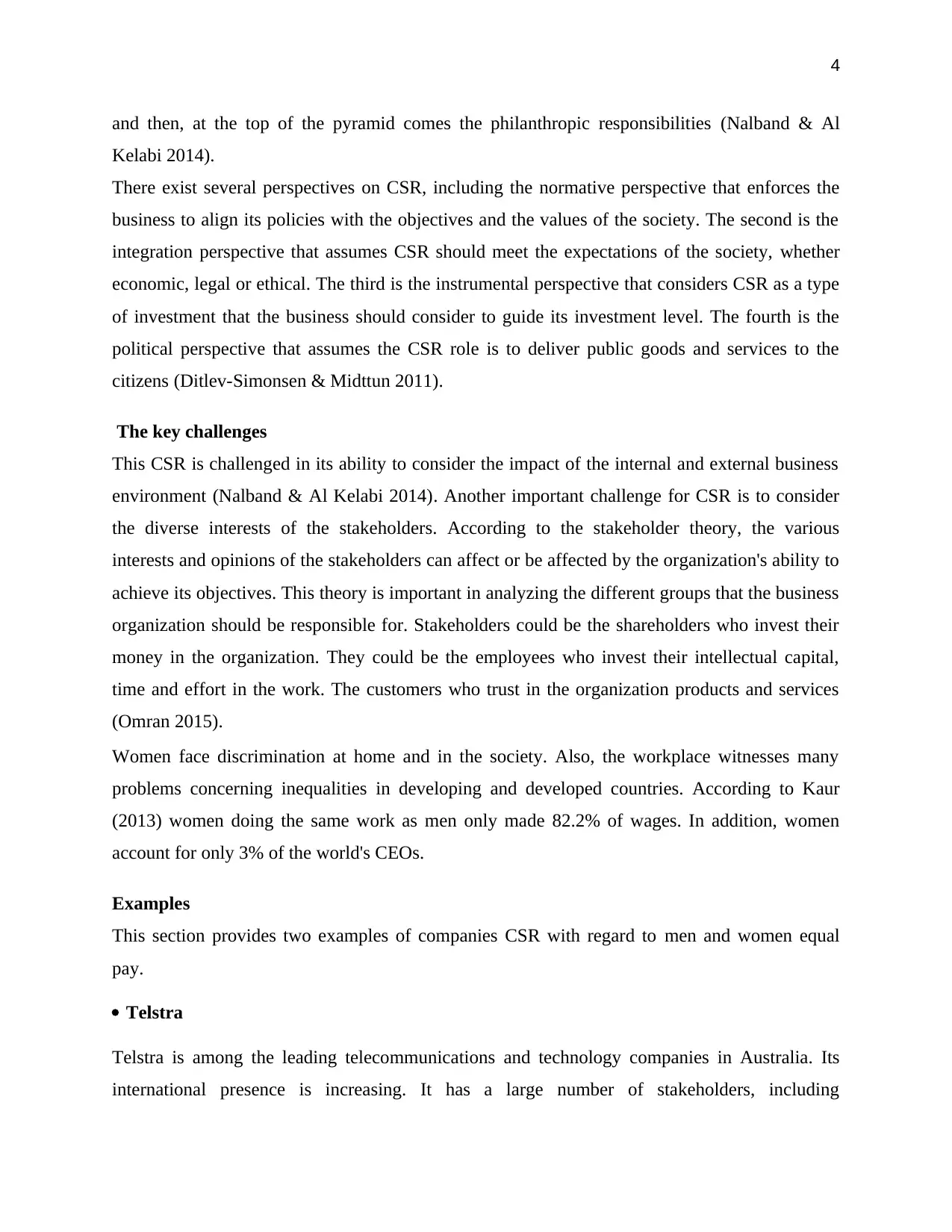
4
and then, at the top of the pyramid comes the philanthropic responsibilities (Nalband & Al
Kelabi 2014).
There exist several perspectives on CSR, including the normative perspective that enforces the
business to align its policies with the objectives and the values of the society. The second is the
integration perspective that assumes CSR should meet the expectations of the society, whether
economic, legal or ethical. The third is the instrumental perspective that considers CSR as a type
of investment that the business should consider to guide its investment level. The fourth is the
political perspective that assumes the CSR role is to deliver public goods and services to the
citizens (Ditlev-Simonsen & Midttun 2011).
The key challenges
This CSR is challenged in its ability to consider the impact of the internal and external business
environment (Nalband & Al Kelabi 2014). Another important challenge for CSR is to consider
the diverse interests of the stakeholders. According to the stakeholder theory, the various
interests and opinions of the stakeholders can affect or be affected by the organization's ability to
achieve its objectives. This theory is important in analyzing the different groups that the business
organization should be responsible for. Stakeholders could be the shareholders who invest their
money in the organization. They could be the employees who invest their intellectual capital,
time and effort in the work. The customers who trust in the organization products and services
(Omran 2015).
Women face discrimination at home and in the society. Also, the workplace witnesses many
problems concerning inequalities in developing and developed countries. According to Kaur
(2013) women doing the same work as men only made 82.2% of wages. In addition, women
account for only 3% of the world's CEOs.
Examples
This section provides two examples of companies CSR with regard to men and women equal
pay.
Telstra
Telstra is among the leading telecommunications and technology companies in Australia. Its
international presence is increasing. It has a large number of stakeholders, including
and then, at the top of the pyramid comes the philanthropic responsibilities (Nalband & Al
Kelabi 2014).
There exist several perspectives on CSR, including the normative perspective that enforces the
business to align its policies with the objectives and the values of the society. The second is the
integration perspective that assumes CSR should meet the expectations of the society, whether
economic, legal or ethical. The third is the instrumental perspective that considers CSR as a type
of investment that the business should consider to guide its investment level. The fourth is the
political perspective that assumes the CSR role is to deliver public goods and services to the
citizens (Ditlev-Simonsen & Midttun 2011).
The key challenges
This CSR is challenged in its ability to consider the impact of the internal and external business
environment (Nalband & Al Kelabi 2014). Another important challenge for CSR is to consider
the diverse interests of the stakeholders. According to the stakeholder theory, the various
interests and opinions of the stakeholders can affect or be affected by the organization's ability to
achieve its objectives. This theory is important in analyzing the different groups that the business
organization should be responsible for. Stakeholders could be the shareholders who invest their
money in the organization. They could be the employees who invest their intellectual capital,
time and effort in the work. The customers who trust in the organization products and services
(Omran 2015).
Women face discrimination at home and in the society. Also, the workplace witnesses many
problems concerning inequalities in developing and developed countries. According to Kaur
(2013) women doing the same work as men only made 82.2% of wages. In addition, women
account for only 3% of the world's CEOs.
Examples
This section provides two examples of companies CSR with regard to men and women equal
pay.
Telstra
Telstra is among the leading telecommunications and technology companies in Australia. Its
international presence is increasing. It has a large number of stakeholders, including
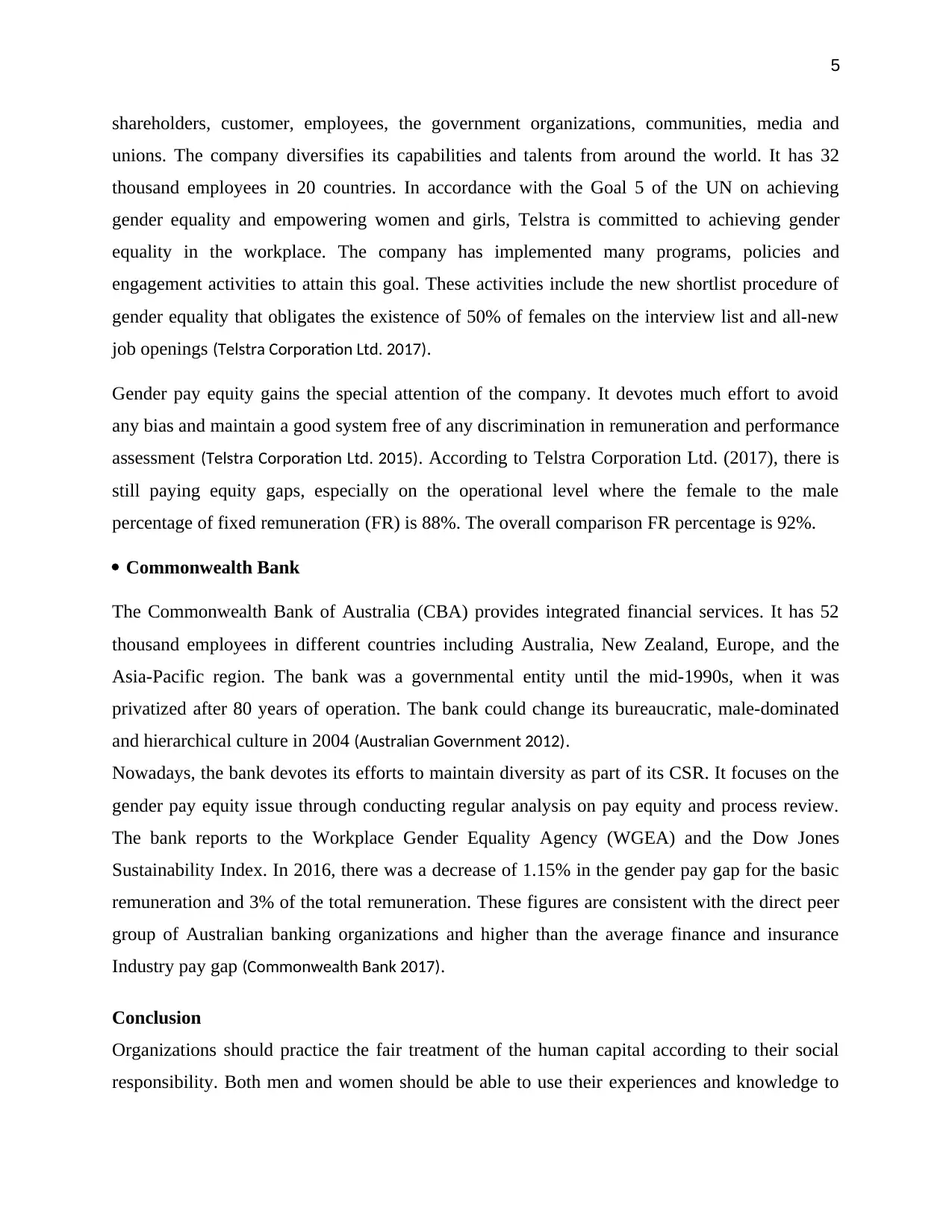
5
shareholders, customer, employees, the government organizations, communities, media and
unions. The company diversifies its capabilities and talents from around the world. It has 32
thousand employees in 20 countries. In accordance with the Goal 5 of the UN on achieving
gender equality and empowering women and girls, Telstra is committed to achieving gender
equality in the workplace. The company has implemented many programs, policies and
engagement activities to attain this goal. These activities include the new shortlist procedure of
gender equality that obligates the existence of 50% of females on the interview list and all-new
job openings (Telstra Corporation Ltd. 2017).
Gender pay equity gains the special attention of the company. It devotes much effort to avoid
any bias and maintain a good system free of any discrimination in remuneration and performance
assessment (Telstra Corporation Ltd. 2015). According to Telstra Corporation Ltd. (2017), there is
still paying equity gaps, especially on the operational level where the female to the male
percentage of fixed remuneration (FR) is 88%. The overall comparison FR percentage is 92%.
Commonwealth Bank
The Commonwealth Bank of Australia (CBA) provides integrated financial services. It has 52
thousand employees in different countries including Australia, New Zealand, Europe, and the
Asia-Pacific region. The bank was a governmental entity until the mid-1990s, when it was
privatized after 80 years of operation. The bank could change its bureaucratic, male-dominated
and hierarchical culture in 2004 (Australian Government 2012).
Nowadays, the bank devotes its efforts to maintain diversity as part of its CSR. It focuses on the
gender pay equity issue through conducting regular analysis on pay equity and process review.
The bank reports to the Workplace Gender Equality Agency (WGEA) and the Dow Jones
Sustainability Index. In 2016, there was a decrease of 1.15% in the gender pay gap for the basic
remuneration and 3% of the total remuneration. These figures are consistent with the direct peer
group of Australian banking organizations and higher than the average finance and insurance
Industry pay gap (Commonwealth Bank 2017).
Conclusion
Organizations should practice the fair treatment of the human capital according to their social
responsibility. Both men and women should be able to use their experiences and knowledge to
shareholders, customer, employees, the government organizations, communities, media and
unions. The company diversifies its capabilities and talents from around the world. It has 32
thousand employees in 20 countries. In accordance with the Goal 5 of the UN on achieving
gender equality and empowering women and girls, Telstra is committed to achieving gender
equality in the workplace. The company has implemented many programs, policies and
engagement activities to attain this goal. These activities include the new shortlist procedure of
gender equality that obligates the existence of 50% of females on the interview list and all-new
job openings (Telstra Corporation Ltd. 2017).
Gender pay equity gains the special attention of the company. It devotes much effort to avoid
any bias and maintain a good system free of any discrimination in remuneration and performance
assessment (Telstra Corporation Ltd. 2015). According to Telstra Corporation Ltd. (2017), there is
still paying equity gaps, especially on the operational level where the female to the male
percentage of fixed remuneration (FR) is 88%. The overall comparison FR percentage is 92%.
Commonwealth Bank
The Commonwealth Bank of Australia (CBA) provides integrated financial services. It has 52
thousand employees in different countries including Australia, New Zealand, Europe, and the
Asia-Pacific region. The bank was a governmental entity until the mid-1990s, when it was
privatized after 80 years of operation. The bank could change its bureaucratic, male-dominated
and hierarchical culture in 2004 (Australian Government 2012).
Nowadays, the bank devotes its efforts to maintain diversity as part of its CSR. It focuses on the
gender pay equity issue through conducting regular analysis on pay equity and process review.
The bank reports to the Workplace Gender Equality Agency (WGEA) and the Dow Jones
Sustainability Index. In 2016, there was a decrease of 1.15% in the gender pay gap for the basic
remuneration and 3% of the total remuneration. These figures are consistent with the direct peer
group of Australian banking organizations and higher than the average finance and insurance
Industry pay gap (Commonwealth Bank 2017).
Conclusion
Organizations should practice the fair treatment of the human capital according to their social
responsibility. Both men and women should be able to use their experiences and knowledge to
⊘ This is a preview!⊘
Do you want full access?
Subscribe today to unlock all pages.

Trusted by 1+ million students worldwide
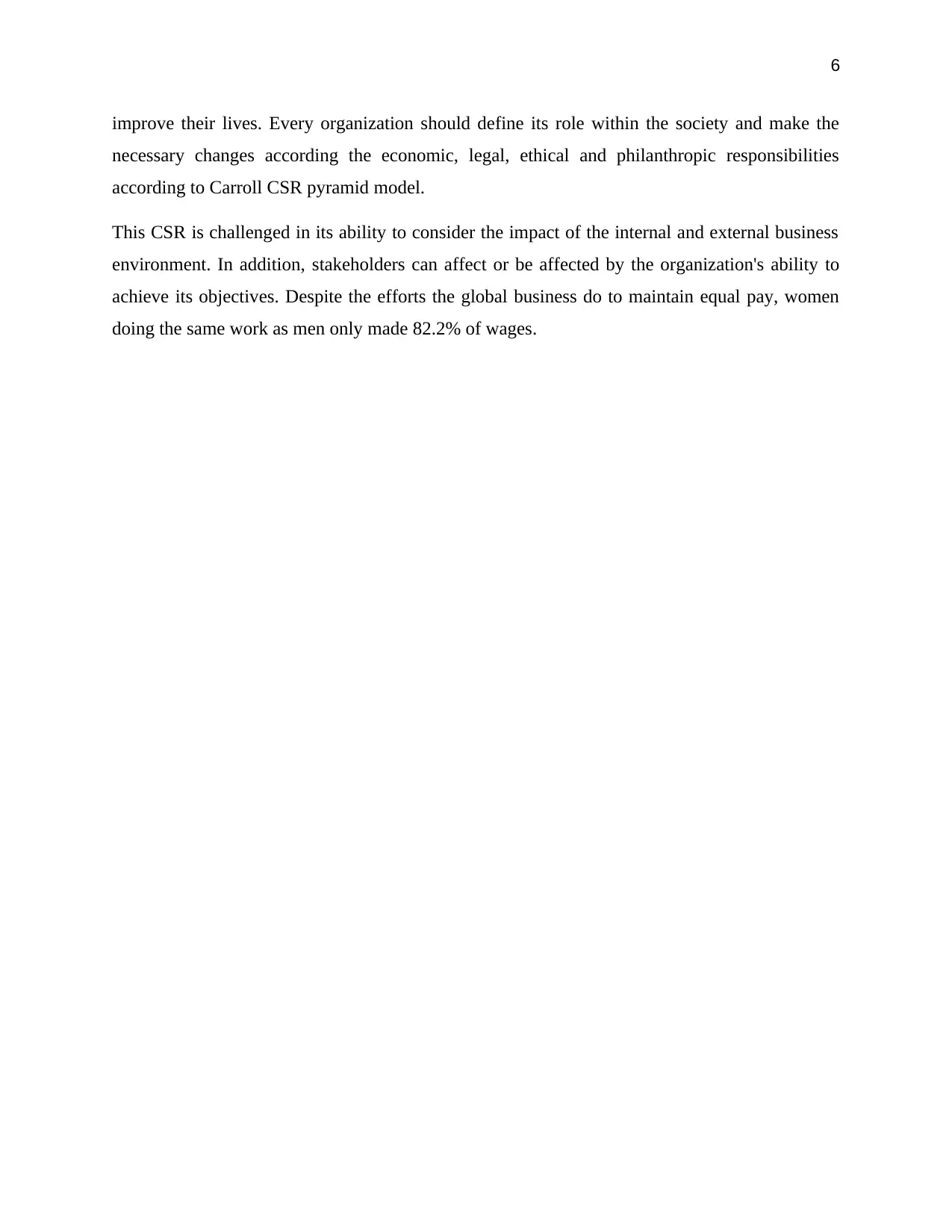
6
improve their lives. Every organization should define its role within the society and make the
necessary changes according the economic, legal, ethical and philanthropic responsibilities
according to Carroll CSR pyramid model.
This CSR is challenged in its ability to consider the impact of the internal and external business
environment. In addition, stakeholders can affect or be affected by the organization's ability to
achieve its objectives. Despite the efforts the global business do to maintain equal pay, women
doing the same work as men only made 82.2% of wages.
improve their lives. Every organization should define its role within the society and make the
necessary changes according the economic, legal, ethical and philanthropic responsibilities
according to Carroll CSR pyramid model.
This CSR is challenged in its ability to consider the impact of the internal and external business
environment. In addition, stakeholders can affect or be affected by the organization's ability to
achieve its objectives. Despite the efforts the global business do to maintain equal pay, women
doing the same work as men only made 82.2% of wages.
Paraphrase This Document
Need a fresh take? Get an instant paraphrase of this document with our AI Paraphraser
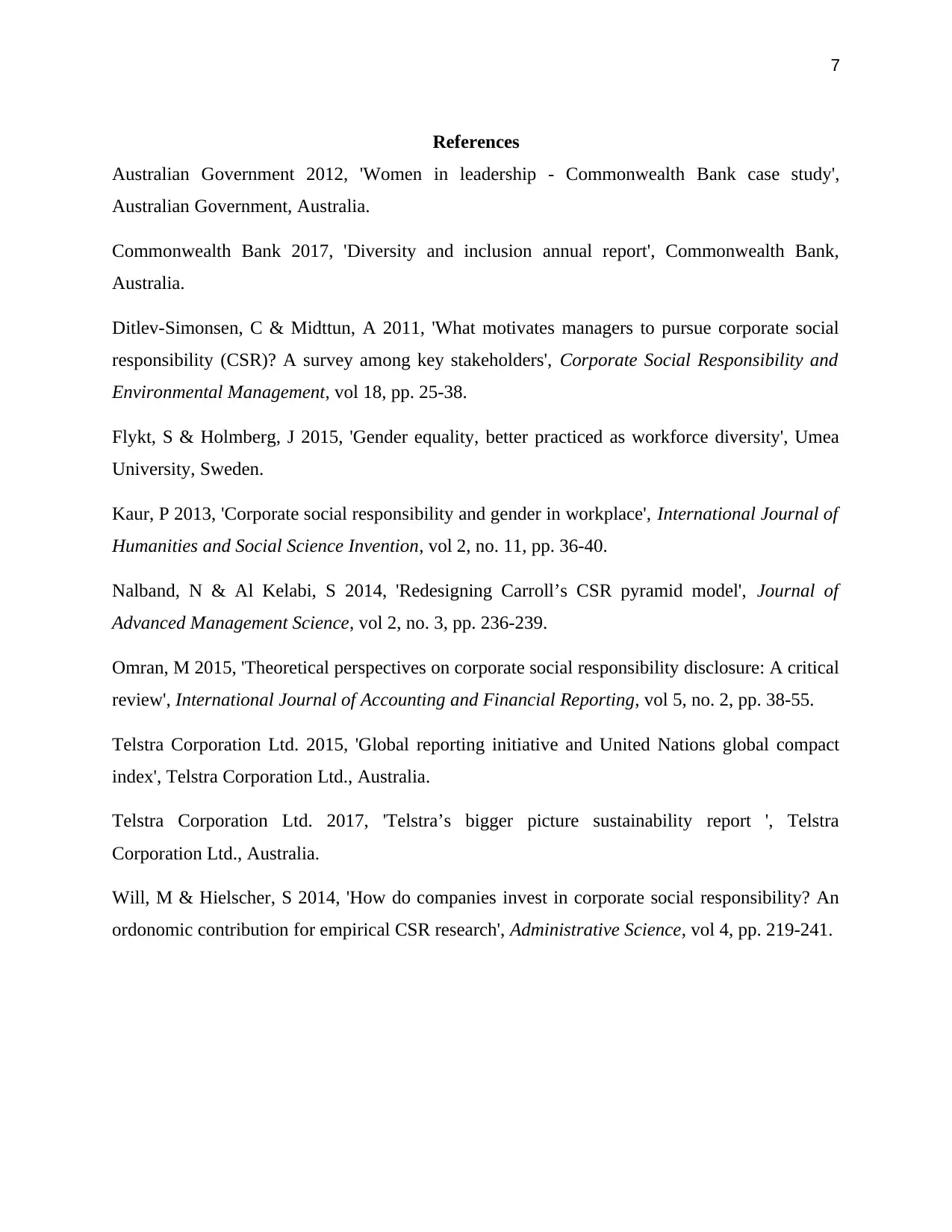
7
References
Australian Government 2012, 'Women in leadership - Commonwealth Bank case study',
Australian Government, Australia.
Commonwealth Bank 2017, 'Diversity and inclusion annual report', Commonwealth Bank,
Australia.
Ditlev-Simonsen, C & Midttun, A 2011, 'What motivates managers to pursue corporate social
responsibility (CSR)? A survey among key stakeholders', Corporate Social Responsibility and
Environmental Management, vol 18, pp. 25-38.
Flykt, S & Holmberg, J 2015, 'Gender equality, better practiced as workforce diversity', Umea
University, Sweden.
Kaur, P 2013, 'Corporate social responsibility and gender in workplace', International Journal of
Humanities and Social Science Invention, vol 2, no. 11, pp. 36-40.
Nalband, N & Al Kelabi, S 2014, 'Redesigning Carroll’s CSR pyramid model', Journal of
Advanced Management Science, vol 2, no. 3, pp. 236-239.
Omran, M 2015, 'Theoretical perspectives on corporate social responsibility disclosure: A critical
review', International Journal of Accounting and Financial Reporting, vol 5, no. 2, pp. 38-55.
Telstra Corporation Ltd. 2015, 'Global reporting initiative and United Nations global compact
index', Telstra Corporation Ltd., Australia.
Telstra Corporation Ltd. 2017, 'Telstra’s bigger picture sustainability report ', Telstra
Corporation Ltd., Australia.
Will, M & Hielscher, S 2014, 'How do companies invest in corporate social responsibility? An
ordonomic contribution for empirical CSR research', Administrative Science, vol 4, pp. 219-241.
References
Australian Government 2012, 'Women in leadership - Commonwealth Bank case study',
Australian Government, Australia.
Commonwealth Bank 2017, 'Diversity and inclusion annual report', Commonwealth Bank,
Australia.
Ditlev-Simonsen, C & Midttun, A 2011, 'What motivates managers to pursue corporate social
responsibility (CSR)? A survey among key stakeholders', Corporate Social Responsibility and
Environmental Management, vol 18, pp. 25-38.
Flykt, S & Holmberg, J 2015, 'Gender equality, better practiced as workforce diversity', Umea
University, Sweden.
Kaur, P 2013, 'Corporate social responsibility and gender in workplace', International Journal of
Humanities and Social Science Invention, vol 2, no. 11, pp. 36-40.
Nalband, N & Al Kelabi, S 2014, 'Redesigning Carroll’s CSR pyramid model', Journal of
Advanced Management Science, vol 2, no. 3, pp. 236-239.
Omran, M 2015, 'Theoretical perspectives on corporate social responsibility disclosure: A critical
review', International Journal of Accounting and Financial Reporting, vol 5, no. 2, pp. 38-55.
Telstra Corporation Ltd. 2015, 'Global reporting initiative and United Nations global compact
index', Telstra Corporation Ltd., Australia.
Telstra Corporation Ltd. 2017, 'Telstra’s bigger picture sustainability report ', Telstra
Corporation Ltd., Australia.
Will, M & Hielscher, S 2014, 'How do companies invest in corporate social responsibility? An
ordonomic contribution for empirical CSR research', Administrative Science, vol 4, pp. 219-241.
1 out of 8
Related Documents
Your All-in-One AI-Powered Toolkit for Academic Success.
+13062052269
info@desklib.com
Available 24*7 on WhatsApp / Email
![[object Object]](/_next/static/media/star-bottom.7253800d.svg)
Unlock your academic potential
Copyright © 2020–2025 A2Z Services. All Rights Reserved. Developed and managed by ZUCOL.





